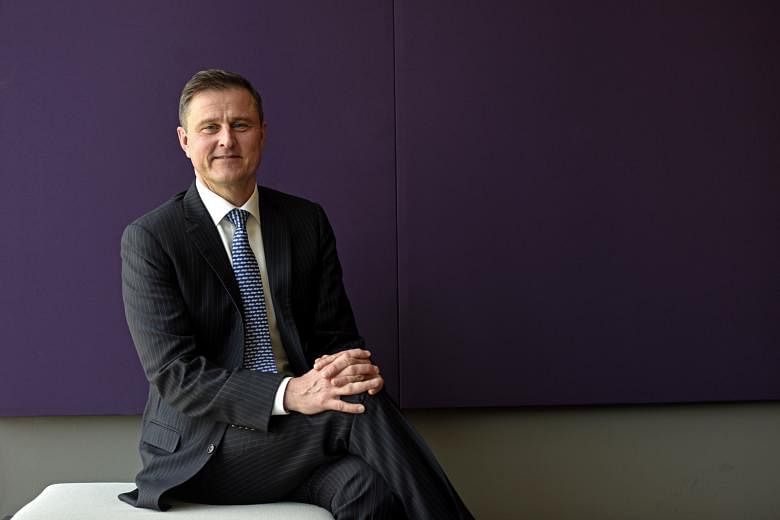Mr Matt Eagan, portfolio manager for multi-sector products at Loomis, Sayles & Company, discusses his outlook on fixed income and investing opportunities in the latest in our series featuring fund managers and leading market experts.
Mr Eagan, who has 24 years of investment industry experience as a portfolio manager and fixed-income analyst, is a co-portfolio manager of the Loomis Sayles Multisector Income Fund.
The fund invests in a global investment universe, including US investment-grade corporates, non-US debt, emerging market debt, high yield, convertibles and equities. Launched in 1997, the fund became available to retail investors in Singapore from June 2013.
It notched up a return of 10.31 per cent (7 per cent after taking into account the 3 per cent maximum sales charge) in the 11 months to Nov 30, compared with 3.82 per cent for the Bloomberg Barclays US Government/Credit total return SGD Index.
Q. Can you briefly explain your multi-sector income approach to navigating market volatility and unearthing opportunities?
A. The fund is guided by the belief that financial markets are inefficient over the short term. Our strategy tends to focus on where the market is mispricing risk in credit, currency and rates. The benchmark does not serve as a starting point for portfolio construction; we will look across global sectors for the best investment opportunities on a risk-adjusted basis.
Q. What are the key opportunities in 2017 in the global bond markets?
A. Looking ahead, the macro environment should gain momentum with steady gross domestic product (GDP) growth globally and in the United States. Inflationary pressures are building and may accelerate, given the potential for fiscal stimulus along with strong employment conditions in the US.
Risk assets can benefit from this backdrop and our current exposure to credit in the fund is more than 45 per cent, which is driving the excess return year-to-date. Credit-risk premiums have declined and current valuations are pointing to late stages of the credit cycle but, in our view, a rebound in corporate profitability can extend this current phase of the credit cycle.
Q. In view of the potential rate hikes over time, how do you manage interest rate risks? What are the other risks investors should watch out for this year?
A. The US presidential election outcome raises the prospect for meaningful fiscal stimulus, less regulation and higher inflation in the coming years. We believe the fund is well-positioned, given our forecast for rates, which includes three hikes by the US Federal Reserve over the next 12 months.
A key risk we are monitoring is the potential negative impact on global growth and our non-US$ holdings under the assumption of a stronger US dollar driven higher by loose fiscal policy, tight monetary policy and restrictive trade policies.
Q. US President-elect Donald Trump is an example of the trend of populist movements, which are turning to fiscal spending. How do you see this affecting growth and inflation in the US? What is the impact for the rest of the world?
A. Any Trump fiscal stimulus is expected to have a greater impact in late 2017 and into 2018. That said, post-election, we have seen a pick-up in risk markets on the expectation of faster GDP growth.
The rise in Treasury yields reflects this view, along with improving employment conditions and accelerating wage gains and inflation expectations.
We have seen positive revisions to the second- and third-quarter GDP growth and would expect this trend to continue this year based on the potential impact of fiscal stimulus.
Fiscal expansion along with tighter employment is expected to pressure US and global inflation higher.
Q. Do you expect to see a change in the investment landscape between now and when Mr Trump takes office? If so, why?
A. We are not expecting a material change in the near-term investment landscape, beyond what we are seeing currently. Investors have largely focused on certain sectors that may be positively impacted by less regulation, lower tax rates and increased infrastructure spending. Specific industries include healthcare, pharmaceuticals, metals, media, technology and financials.
Q. Moving into the year, what advice would you give investors?
A. It will be important to remain patient. At this time, we do not know the scope or magnitude of any policy changes. In addition, there are a number of key developments to monitor - central bank action, Opec, regulatory changes - which should provide greater clarity.
We feel our portfolios are well-positioned and have the flexibility to adjust as market conditions unfold and investors attempt to appropriately price the financial implications and risks.
Fixed-income investors have been conditioned to expect low rates and inflation for many years, but they also dislike today's ultra-low yields and the exposure their portfolios have, should these trends one day reverse.
In fact, there are signs now that suggest inflation and yields are indeed poised to rise on a more sustainable basis. We think investors should not be overly concerned about this for two reasons.
First, rising yields will ultimately be good for fixed-income investors as they will be able to earn a better return by boosting reinvestment rate returns.
Second, investors can reduce their exposure to risk arising from shifting market expectations of interest rates.
They can do that while staying in the fixed-income space by investing in multi-sector strategies that can move away from the developed government bond markets that are most exposed to inflation. They can invest in corporate bonds and bonds that are less sensitive to general interest rate moves.
Diversification is the key to success in navigating today's bond market. The goal is to get to a higher level of yields while protecting principal. We believe a multi-sector, unconstrained approach is the best way to reach that goal.


